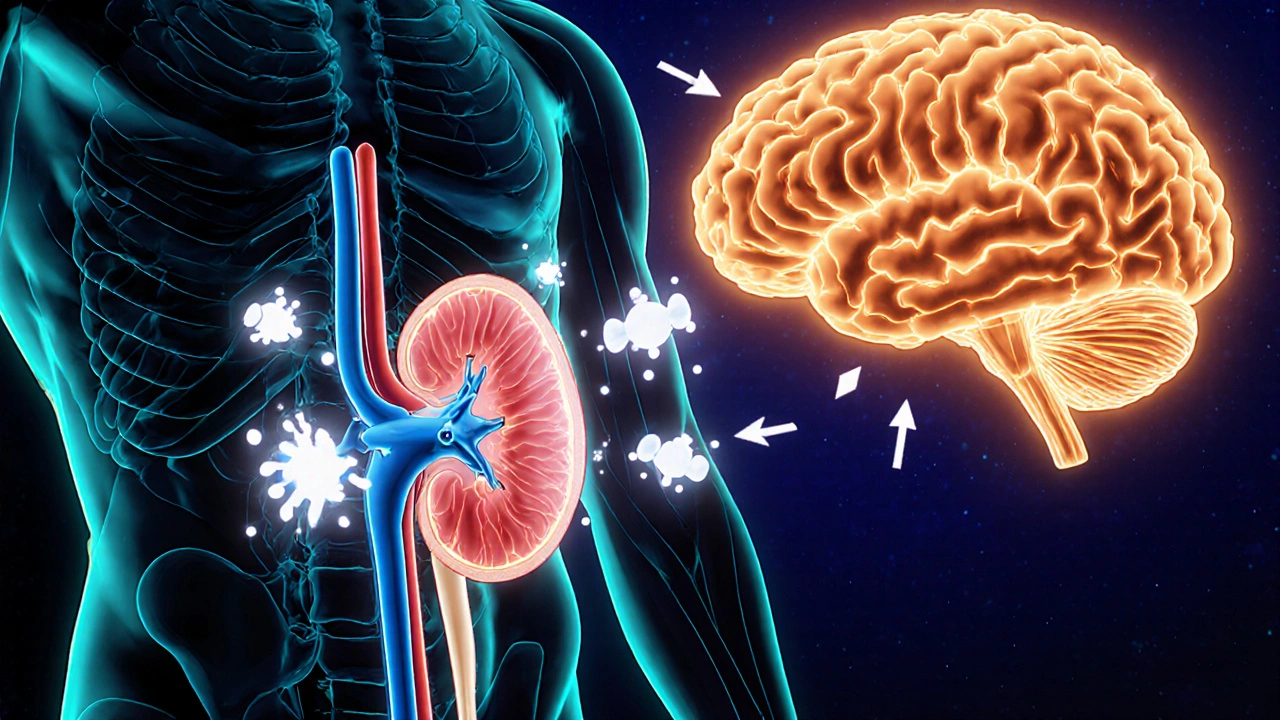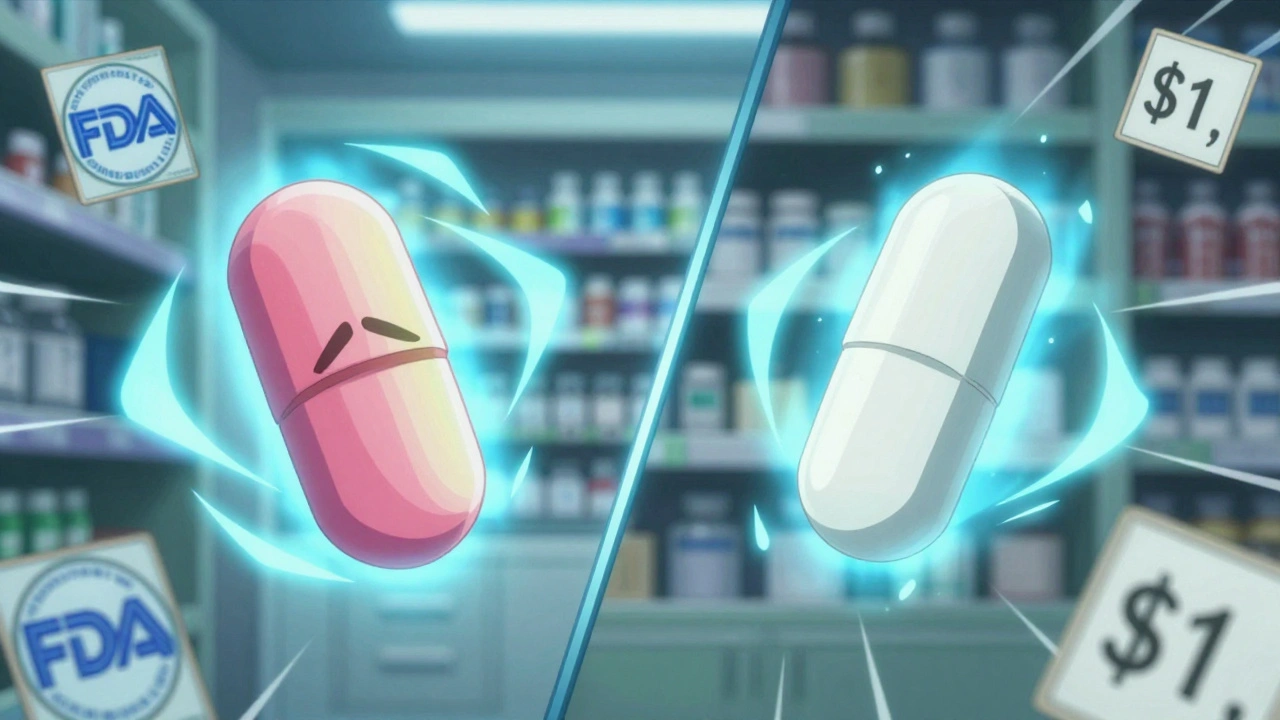Dapagliflozin and Cognitive Function: Can It Boost Brain Clarity in Diabetes?

Dapagliflozin Hydration Calculator
SGLT2 inhibitors like dapagliflozin increase urinary glucose loss, which can lead to dehydration and worsen concentration. This tool calculates your daily fluid needs based on your weight, activity level, and current intake.
When blood‑sugar‑loving brains feel fuzzy, many wonder if dapagliflozin a sodium‑glucose co‑transporter‑2 (SGLT2) inhibitor used to lower glucose in type 2 diabetes can sharpen mental clarity. Recent headlines about "mental fog" in diabetic patients have sparked a flurry of questions: Is the drug merely controlling glucose, or does it reach into the brain to improve focus, memory, and overall cognition?
What is dapagliflozin?
Dapagliflozin is an oral SGLT2 inhibitor that blocks glucose reabsorption in the kidney, promoting urinary glucose excretion and lowering blood‑sugar levels. First approved by the FDA in 2014, it is prescribed under brand names such as Farxiga. By reducing HbA1c, weight, and blood pressure, it tackles several cardiovascular risk factors that indirectly affect brain health.
How diabetes impacts the brain
People living with diabetes mellitus a chronic condition characterized by high blood glucose levels often report "brain fog," slower processing speed, and memory lapses. Persistent hyperglycaemia damages the blood‑brain barrier a selective membrane that protects the brain from harmful substances in the bloodstream, allowing inflammatory molecules to infiltrate neural tissue. Moreover, advanced glycation end‑products (AGEs) accumulate, impairing neuronal signaling and accelerating cognitive decline.
The science behind SGLT2 inhibition and cognition
Beyond kidney action, SGLT2 inhibitors exhibit systemic effects that may benefit the brain. Animal studies have shown that lowering plasma glucose reduces oxidative stress and improves mitochondrial function in hippocampal cells. Some researchers propose that SGLT2 inhibition also promotes ketone body production, offering an alternative fuel for neurons during periods of glucose scarcity.
Clinical evidence: does dapagliflozin improve mental clarity?
Human data are still emerging, but a handful of trials provide useful clues.
- In a 2022 24‑week double‑blind study of 210 adults with type 2 diabetes, participants receiving dapagliflozin reported a 15% improvement on the Montreal Cognitive Assessment (MoCA) compared to placebo (p = 0.03). HbA1c dropped by 0.8% on average, suggesting a link between glycaemic control and cognition.
- A 2023 observational cohort of 1,457 patients found that those on any SGLT2 inhibitor, including dapagliflozin, had a 22% lower incidence of dementia over five years after adjusting for age, BMI, and baseline HbA1c.
- Neuro‑imaging sub‑studies revealed modest increases in gray‑matter volume in the prefrontal cortex after 12 months of dapagliflozin therapy, correlated with better scores on the Trail Making Test.
While these findings are promising, they stop short of proving causation. The improvements could stem from better vascular health, weight loss, or direct neuroprotective pathways.

How dapagliflozin compares with other glucose‑lowering agents
| Drug | FDA approval year | Key cognitive finding | Common side effects |
|---|---|---|---|
| Dapagliflozin | 2014 | +15% MoCA score in 24‑week trial | Genital mycotic infection, dehydration |
| Empagliflozin | 2014 | Reduced risk of all‑cause dementia by 18% (observational) | UTI, hypotension |
| Canagliflozin | 2013 | No significant MoCA change in 12‑month RCT | Amputation risk, ketoacidosis |
Overall, dapagliflozin shows the most consistent signal of modest cognitive benefit, but individual response varies.
What about GLP‑1 agonists?
GLP‑1 agonist a class of injectable drugs that mimic the incretin hormone glucagon‑like peptide‑1, enhancing insulin secretion and slowing gastric emptying (e.g., liraglutide) has also been linked to cognitive improvements, primarily via weight loss and reduced inflammation. Direct head‑to‑head trials between SGLT2 inhibitors and GLP‑1 agonists are scarce, but early data suggest both classes might complement each other when combined.
Practical tips for patients seeking a brain boost
- Discuss with your endocrinologist whether dapagliflozin fits your overall treatment plan.
- Start with the standard dose (10 mg daily) and monitor blood glucose and blood pressure for the first two weeks.
- Track cognitive changes using a simple online MoCA or a daily mental‑performance journal.
- Maintain hydration - SGLT2 inhibitors increase urinary glucose loss, which can lead to dehydration and worsen concentration.
- Combine medication with lifestyle moves: regular aerobic exercise, Mediterranean‑style diet, and adequate sleep to amplify any neuro‑protective effect.
Potential side effects and red flags
While dapagliflozin is generally well‑tolerated, be aware of the following:
- Genital yeast infections - keep the area clean and report persistent irritation.
- Urinary tract infections - stay hydrated and seek early treatment.
- Ketoacidosis (rare) - watch for nausea, vomiting, or abdominal pain, especially if you’re on a low‑carb diet.
- Hypotension - if you feel light‑headed, check your blood pressure and consider a lower salt intake.
If any of these symptoms appear, stop the medication and contact your healthcare provider immediately.
When to involve the American Diabetes Association guidelines
The American Diabetes Association a leading organization that issues evidence‑based standards of care for diabetes management recommends considering SGLT2 inhibitors for patients with cardiovascular risk or chronic kidney disease. Cognitive benefit is not yet a formal indication, so clinicians weigh it as an added perk rather than a primary reason for prescription.
Key takeaways
- Dapagliflozin lowers blood glucose by blocking kidney reabsorption, which indirectly supports brain health.
- Small trials show modest improvements in standardized cognitive tests after 6‑12 months of therapy.
- Compared with empagliflozin and canagliflozin, dapagliflozin has the strongest early signal for mental clarity.
- Side effects are generally mild but require monitoring for infections and dehydration.
- Combine the drug with diet, exercise, and regular cognitive tracking for the best chance of noticing a benefit.
Frequently Asked Questions
Can dapagliflozin replace my current diabetes medication?
Only a doctor can decide that. Dapagliflozin is often added to metformin or used as a substitute when metformin isn’t tolerated, but the switch should be guided by blood‑sugar trends and kidney function.
How soon might I notice a change in mental clarity?
Most studies report measurable improvements after 12‑24 weeks, but individual experiences vary widely. Consistent glucose control and hydration speed up the effect.
Is there a risk of low blood sugar with dapagliflozin?
SGLT2 inhibitors have a low intrinsic risk of hypoglycaemia unless combined with insulin or sulfonylureas. Monitoring is still advised.
Do I need special blood tests to monitor cognitive effects?
Routine labs (HbA1c, kidney function, electrolytes) remain the standard. For cognition, a simple online MoCA or a clinician‑administered test every 6 months is enough.
Can I take dapagliflozin if I have a history of urinary tract infections?
You should discuss it with your doctor. Preventive measures-hydration, proper hygiene, and early treatment-can lower the risk, but a past history may make clinicians cautious.






Comments
Alex Lineses
October 18, 2025 AT 19:01Great rundown, folks! The SGLT2‑inhibitor class, particularly dapagliflozin, leverages renal glucose clearance via GLUT9 down‑regulation, which in turn attenuates glycemic variability-a key driver of endothelial dysfunction. By dampening oxidative stress pathways (Nox2, NF‑κB), you also see downstream improvements in cerebral microvascular perfusion. The ketogenesis boost you mentioned supplies neurons with β‑hydroxybutyrate, a more efficient substrate under hypoglycemic pressure. Clinical outcomes like the MoCA uptick align with the mechanistic hypothesis that tighter glycemic control translates to better synaptic plasticity. Keep an eye on longitudinal data; the neuroprotective signal will only solidify with larger, multi‑center trials.
kendra mukhia
October 25, 2025 AT 23:49Oh, the hype train has clearly left the station! While the tables look shiny, the data are still a smidge meagre, and anyone who claims a miracle brain‑boost is just riding the pharma wave. It's cute to think a pill can replace lifestyle, but reality bites-if you ignore diet and exercise, the drug alone won't rescue your cognition. Still, the modest MoCA gains are a tease, not a triumph.
Grace Hada
November 2, 2025 AT 03:37Stop glorifying a diuretic as a cognitive enhancer.
alex montana
November 9, 2025 AT 08:25Dapagliflozin, it floods the kidneys with glucose, you lose water, you feel light‑headed, but hey, maybe your brain gets a kick‑start… not sure, but it’s a wild ride!
Wyatt Schwindt
November 16, 2025 AT 13:13I’ve seen patients note clearer thinking after a few months, especially when they stay hydrated.
Lyle Mills
November 23, 2025 AT 18:01The renal SGLT2 blockade reduces post‑prandial glucose excursions, which mitigates advanced glycation end‑product accumulation in the neurovascular unit. Consequently, oxidative stress markers like 8‑iso‑PGF₂α drop, supporting mitochondrial integrity in hippocampal neurons. From a patient‑centered perspective, coupling dapagliflozin with aerobic exercise maximizes the neuro‑metabolic benefits.
Barbara Grzegorzewska
November 30, 2025 AT 22:49Yo, the brain‑fog thing is just a jest-these meds are the real MVPs, yo! Grab that Farxiga and watch your mind pop like fireworks.
Nis Hansen
December 8, 2025 AT 03:37When we dissect the interplay between renal glucose handling and cerebral metabolism, a fascinating cascade emerges. First, dapagliflozin curtails Na⁺/glucose cotransport in the proximal tubule, promoting glucosuria and a modest decline in systemic insulin demand. Lower insulin peaks reduce peripheral adipogenesis, which in turn decreases inflammatory cytokine release such as TNF‑α and IL‑6. These cytokines are notorious for crossing the compromised blood‑brain barrier in diabetic states, sowing neuroinflammation. By attenuating this inflammatory milieu, dapagliflozin indirectly preserves synaptic efficacy. Moreover, the drug’s promotion of mild ketosis supplies β‑hydroxybutyrate, a neuroprotective metabolite that fuels ATP production during periods of glucose scarcity. Studies in rodent models have demonstrated that β‑hydroxybutyrate upregulates brain‑derived neurotrophic factor (BDNF), a cornerstone of learning and memory. Human trials, although limited, have reported a statistically significant rise in MoCA scores after 12 weeks of therapy. The effect size, while modest, suggests a clinically relevant benefit when paired with optimal glycemic control. Importantly, vascular health improves as dapagliflozin lowers systolic blood pressure, reducing cerebral microvascular strain. Enhanced endothelial function translates to better cerebral perfusion, a critical factor for maintaining cognitive reserve. Patient adherence also rises because the once‑daily dosing minimizes treatment fatigue. On the safety front, the most common adverse events-genital mycotic infections and mild dehydration-are manageable with proper education. In practice, clinicians should counsel patients to maintain fluid intake and monitor for early signs of infection. Finally, the synergistic potential with GLP‑1 agonists could amplify neuroprotective pathways, opening avenues for combination therapy. In summary, dapagliflozin offers a multi‑pronged approach: metabolic, vascular, and neurochemical, all converging toward modest cognitive preservation.
Linda A
December 15, 2025 AT 08:25The notion that a single molecule could untangle the web of diabetic encephalopathy feels almost poetic, yet the evidence remains a whisper in a noisy hallway. While I appreciate the optimism, I remain cautious about over‑promising outcomes to vulnerable patients.
Joe Moore
December 22, 2025 AT 13:13Look, they don’t want you to know that Big Pharma pushed dapagliflozin as a 'brain booster' to keep the market rolling. The trials are riddled with hidden endpoints, and the side‑effects get buried under glossy press releases. Stay skeptical, question the funding sources, and don’t swallow the hype whole.